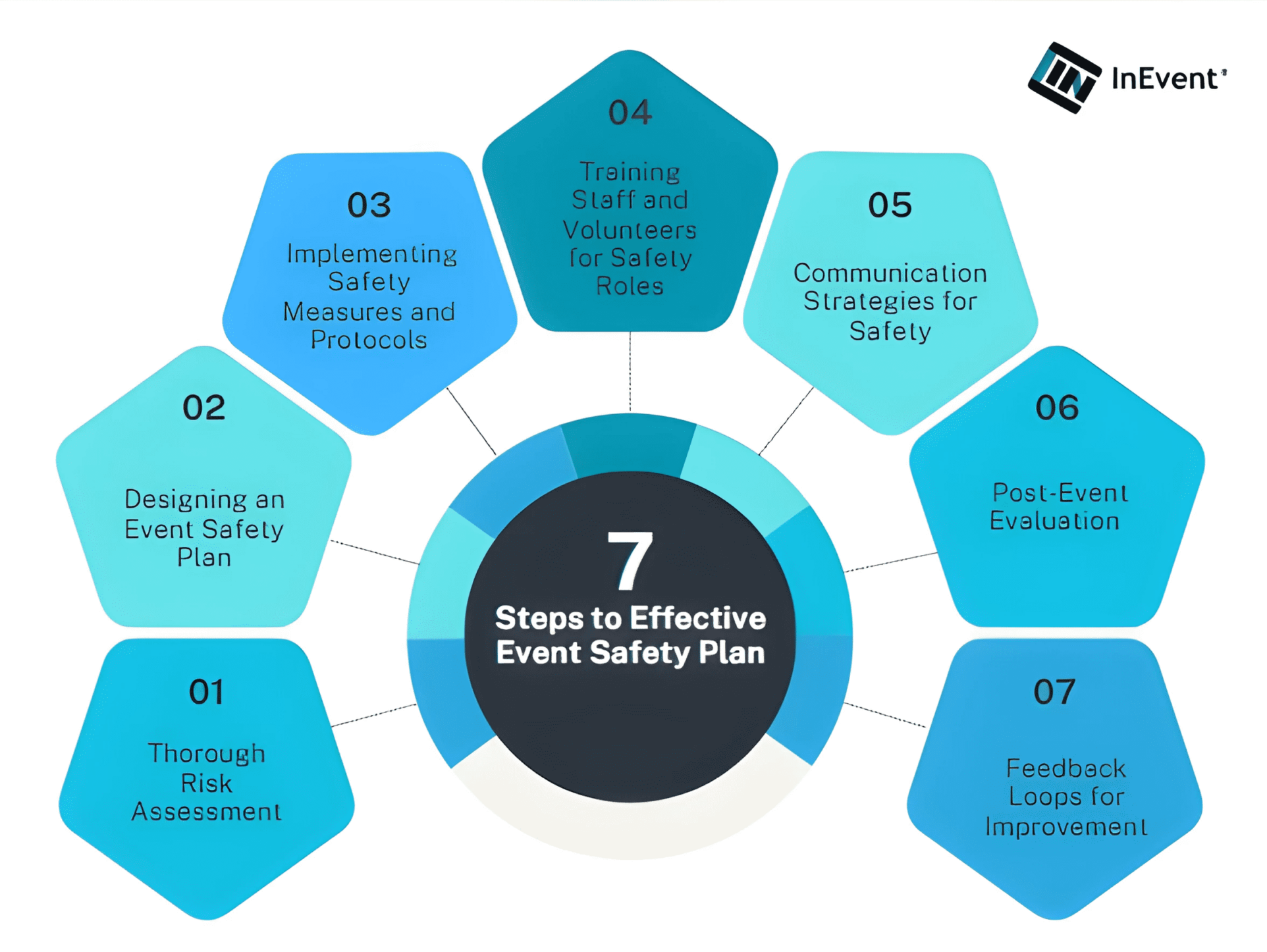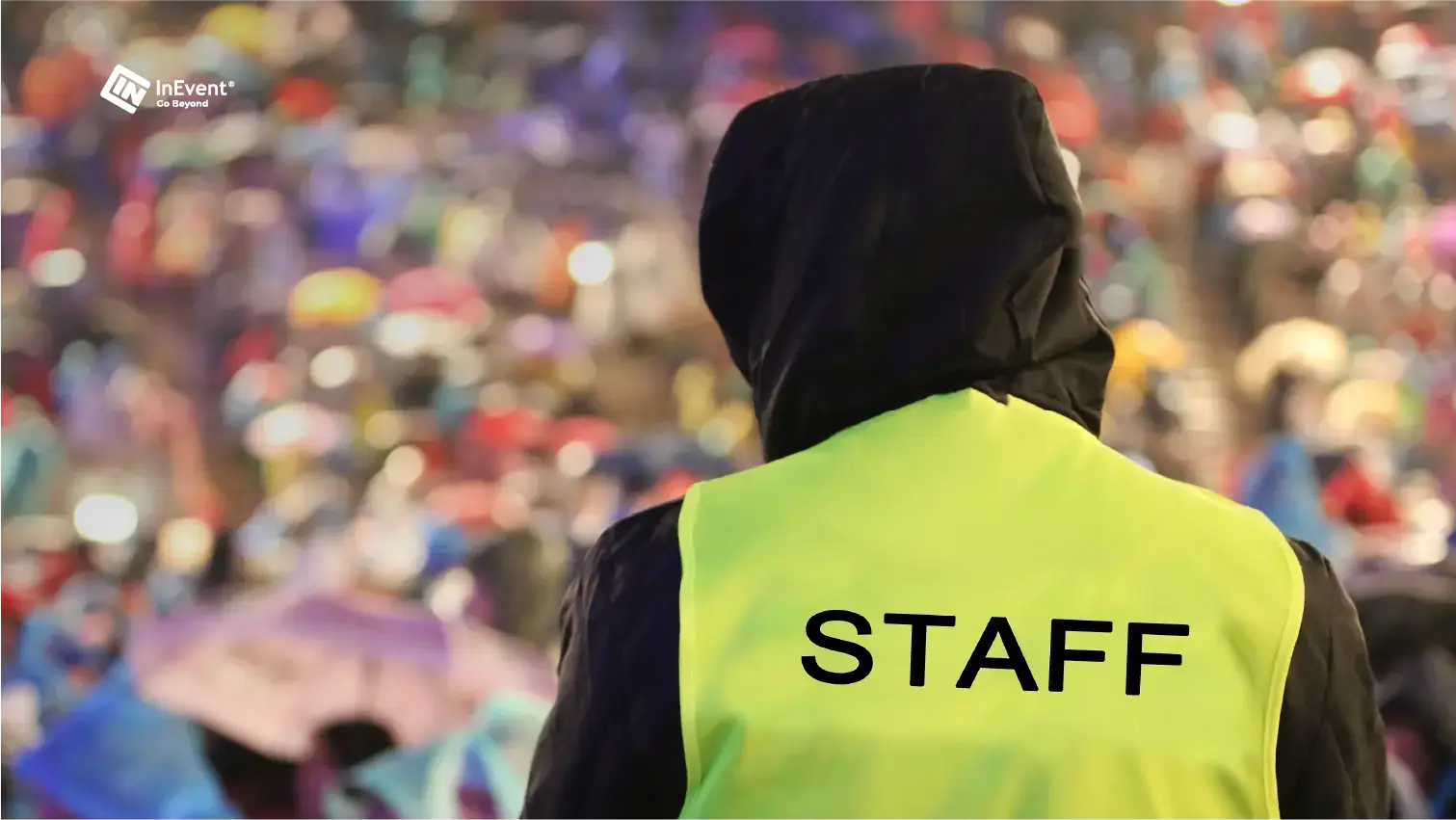Posted on December 13, 2023
In 2024, making an effective event safety plan is more important than ever. Whether it’s a small meeting or a big festival, making your event safe shows you care about your guests and protects your brand’s reputation. With more virtual and hybrid events, event safety and security need careful planning and execution. By focusing on event safety planning now, you’re preparing for successful and safe events that make a good impression.
This article is your guide to understanding the basics of event safety and creating and implementing an effective plan. We’ll also discuss training staff and volunteers, sharing safety information, and reviewing safety after the event. By the end, you’ll know how to manage and organize safe events that impress attendees and stakeholders.
Understanding Event Safety and Its Importance
What is Event Safety?
Event safety means taking steps to reduce risks at events using different methods. These methods include managing crowds, preparing for emergencies, ensuring safe infrastructure, following health rules, and improving security. The main goal is to keep attendees safe and ensure everyone has a good time. This thorough approach has changed a lot over time, primarily because of past tragedies at public events like the flooding incident at the burning man event of 2023 or the Astroworld event tragedy of 2021, showing how important careful safety planning is.
Legal and Ethical Considerations
Leaders in event planning have a big responsibility to foresee and handle possible life-threatening situations. This duty goes beyond just following laws; it includes creating a safety culture throughout the organization. By keeping up with the best safety practices and always learning and adapting, event planners can significantly reduce risks. Also, ethical issues like data protection during event planning is essential now, especially with increasing digital threats. Keeping event attendees safe protects the organization’s reputation and ethical standing.
7 Steps Involved In Creating An Effective Event Safety Plan

Creating a solid event safety plan involves several necessary steps. This section will cover the 7 essential steps to developing an effective safety plan. These steps are designed to help you anticipate risks, implement preventive measures, and respond effectively to any incidents. By following these guidelines, you’ll ensure the safety of your attendees and uphold your organization’s reputation. You can be confident that you are well-prepared for any situation.
1. Conducting a Thorough Risk Assessment
I. Identifying Potential Hazards
Conducting a thorough risk assessment starts by identifying what could go wrong at your event. This is crucial for ensuring participant and attendee safety and contributes to the smooth running of your event. Here are the types of risks you should assess:
- General Considerations: These include broad risks that can affect any event, such as unexpected weather changes, technical failures, or logistical challenges. For example, even indoor events can suffer from inclement weather, leading to issues like power outages.
- Health Risks: With events bringing people together, health risks such as the spread of infectious diseases are a concern. Implementing measures like sanitation stations and health screenings can be beneficial.
- Security Risks: These involve protecting people and property from threats like unauthorized access, theft, or vandalism. Security checks and surveillance are vital measures here.
- Crowd Control Risks: Large gatherings can lead to overcrowding and may require emergency evacuations. Effective crowd management strategies are essential for safety.
- Personal Safety: This covers the risk of accidents or injuries to individuals at the event. Ensuring safe environments and having medical assistance on hand are crucial preventive measures.
- Location Risks: Every event venue has its unique risks, such as structural issues or limited access points, which require tailored solutions.
- Virtual Risks: Online events avoid many physical risks but face potential issues like data breaches or technical disruptions. For hybrid events, both in-person and virtual risks must be considered.
II. Assessment Tools and Techniques
To manage these risks effectively, using the right tools and techniques is essential. Here are some key risk management tools prevalent in 2024:
- Risk Assessment Templates and Checklists: Basic yet effective for identifying and recording potential risks in a structured format.
- Risk Analysis Software: Uses statistical models and simulations to analyze risk scenarios and their potential impacts.
- Project Management Software: The InEvent management platform is an excellent example of project management software. Certain features, such as attendee tracking, luggage tracking, flight and transportation tracking systems, and hotel and accommodations logs, are all risk management features, allowing for seamless risk tracking alongside project milestones.
- Cybersecurity Assessment Tools: Essential for identifying vulnerabilities in an organization’s digital infrastructure to prevent cyber attacks.
These tools help create a safer, more enjoyable event by guiding you through effectively identifying and mitigating risks. Whether your event is in-person or virtual, a detailed checklist of evaluated risks ensures nothing gets missed on the event day.
2. Designing an Effective Event Safety Plan
I. Set Your Objectives
When designing your event safety plan, start by setting clear, achievable objectives. These objectives should be SMART: Specific, Measurable, Attainable, Relevant, and Timely. For instance, an objective might be to increase event registration safety protocols by 20% over the previous year by implementing more rigorous security checks. This goal is specific (enhancing security measures), measurable (20% increase), attainable (with proper resources and planning), relevant (improves overall event safety), and timely (by the next event date).
II. Strategies for Risk Mitigation
-
- Risk Identification and Prioritization: Begin by identifying potential risks using tools like the Event Safety Assessment Checklist. Once identified, prioritize these risks based on their potential impact and likelihood. This helps in focusing resources on the most critical areas first.
- Implementing Mitigation Strategies:
-
- Challenge the Risk: Monitor and manage predictable risks until they require intervention. For instance, if bad weather is forecasted, have plans ready to adjust event schedules or locations.
- Exercise the Risk: Conduct drills and simulations to prepare for possible scenarios, such as fire evacuations or crowd control, to ensure that your team can respond effectively in real situations.
- Isolate the Risk: Isolate risks associated with specific parts of your event, such as data security, by using event management tools with the highest level of data encryption and secure payment preferences
- Buffer the Risk: Allocate extra resources, such as additional security personnel or backup power supplies, to mitigate risks that cannot be controlled entirely.
- Quantify the Risk: Assess the cost versus benefit of each risk. For example, decide if the potential revenue from an event under risky conditions justifies the potential costs from safety incidents.
- Regular Review and Adjustment: Safety plans should not be static. Regularly review and adjust your strategies based on new information or changes in the event environment to ensure continuous improvement and adaptation to new challenges.
By setting clear objectives and employing various risk mitigation strategies, you can create a compelling event safety plan that ensures a secure and enjoyable experience for all participants.
3. Implementing Safety Measures and Protocols
Implementing safety measures and protocols is a crucial step in ensuring the success and safety of your event. This involves a combination of well-trained personnel, advanced technology, and thorough health and emergency response preparations. Let’s examine the specifics.
I. Security Personnel and Equipment
- Training Staff for Vigilance: It is essential to train your staff to recognize and report suspicious items. Teach them the acronym HOT: Hidden, Obviously suspicious, and not Typical. This guideline helps them identify items that may be hidden intentionally, have suspicious electronics, odors, or powders, and aren’t typical for the event setting.
- Collaboration with Authorities: Establishing communication with local authorities ensures quick and effective responses to security threats. This partnership is vital for handling suspicious items and preventing potential crises.
- Advanced Security Technologies: Use the latest security technologies to make your event much safer. These include explosive detection systems, metal detectors, and X-ray screening Equipment. For more significant events, consider walk-through metal detectors for efficient screening.
- Visible Security Measures: Ensure your security team is easily identifiable to attendees. This can be achieved through uniforms or Hi-Vis jackets, especially for outdoor or poorly lit events. Visible security not only deters potential threats but also reassures your guests.
II. Health and Emergency Response Preparations
- Adherence to Public Health Guidelines: If your event coincides with flu season, follow guidelines from public health authorities like the CDC. Implement frequent handwashing protocols and set up sanitation stations to reduce the spread of germs.
- First Aid and Emergency Teams: These teams are your event’s superheroes. They’re trained to respond swiftly to minor injuries and more severe emergencies. Ensure they’re equipped with first aid kits and know the event layout well for quick response.
- Evacuation and Shelter-in-Place Plans: Develop clear evacuation and shelter-in-place plans. Conduct drills with your team to ensure everyone knows their role in an emergency. Also, designate assembly locations outside the venue where attendees can regroup safely.
- Special Needs Consideration: Identify attendees with special needs or disabilities who may require assistance during an evacuation. Assign team members to aid these individuals, ensuring everyone’s safety.
By implementing these safety measures and protocols, you’re not just organizing an event; you’re creating a secure environment where attendees can focus on enjoying the experience without worry. Remember, the key to effective event safety planning lies in preparation, collaboration, and the right technology.
4. Training Staff and Volunteers for Safety Roles

I. Skill Requirements
Training staff and volunteers effectively are crucial for ensuring they are equipped to handle safety roles at your event. Here are the key steps to ensure thorough training:
- Comprehensive Online Training: Ensure all non-SMC Employees complete the necessary online training modules before arriving on-site. This includes understanding the basics of event safety, emergency response, and proper use of personal protective equipment (PPE).
- Hands-On Orientation: Schedule an orientation session where physical demonstrations and role-playing can be conducted to reinforce online training.
- Continuous Learning: Encourage staff and volunteers to engage in ongoing training sessions offered by credible agencies like FEMA’s Emergency Management Institute to stay updated on the latest safety protocols and emergency response techniques.
II. Emergency Response Drills
Conducting effective emergency response drills is vital for preparing your team to act swiftly and efficiently in case of an incident. Here’s how to ensure your drills are successful:
- Realistic Simulations: Engage in full-scale emergency drills, such as evacuating a building or conducting a lockdown, to test your team’s response time and readiness.
- Tabletop Exercises: For less disruptive training, run tabletop exercises that simulate emergency scenarios. This allows the team to practice their roles and refine the response strategy without impacting the entire event’s operations.
- Inclusion of All Staff Levels: Ensure that leadership, safety leaders, and all employees participate in the drills to promote comprehensive engagement and preparedness.
- After-Action Reviews: After each drill, gather key stakeholders to evaluate its effectiveness. Based on these insights, discuss what was successful, what needs improvement, and how to enhance future drills.
By incorporating these training and drill strategies, you equip your staff and volunteers with the knowledge and skills needed to ensure the safety and security of all event participants.
5. Communication Strategies for Safety Information
I. To Staff and Participants
Effective communication is crucial for maintaining safety at your event. Here are some strategies to ensure everyone is on the same page:
- Pre-Event Training and Information Sharing: Engage all event staff and volunteers in comprehensive training sessions. Explain safety protocols and emergency procedures using simple, straightforward language. Incorporate visual aids like diagrams and posters to improve understanding.
- Continuous Updates: Establish a system for ongoing communication throughout the event. Use platforms like email or text groups to rapidly share updates and critical information. This ensures that all staff and participants are informed of any changes or emergencies.
- Inclusive Communication: Make sure to include all personnel in safety communications. This includes security staff, vendors, maintenance crews, and front-line workers like ticket takers and food vendors. Encourage a ‘see something, say something’ culture by clearly communicating how and to whom they should report suspicious activities or safety concerns.
- Feedback Mechanisms: Set up channels for receiving real-time feedback from staff and participants. This could be through mobile apps or dedicated helplines. Feedback is vital for adjusting protocols and responding to issues as they arise.
II. Make Use of Technology for Effective Communication
Leverage the latest technology to streamline communication and enhance safety at your event:
- Mobile and Wearable Technology: Use the InEvent intuitive registration platform and wearable devices to facilitate quick check-ins and provide staff and attendees with real-time updates. Technologies like smart badges can also enhance networking while ensuring that event organizers can track attendance and participant location if necessary.
- Crisis Communication Platforms: Implement platforms designed explicitly for managing communication during crises. These tools help coordinate between security teams, event organizers, and emergency services, ensuring everyone receives accurate information swiftly.
- Surveillance and Reporting Tools: Use surveillance technologies such as CCTV and deploy plainclothes officers or security staff equipped with communication tools to monitor and report unusual activities discreetly.
- Advanced Communication Tools: Consider using communication drones and AI-powered chatbots for more significant events. Drones can provide mobile communication relays in areas where traditional systems might fail, while chatbots can offer instant responses to attendee queries, enhancing the overall experience and safety.
By integrating these communication strategies and technologies, you can ensure a safe and secure environment for all event participants, making your event enjoyable and reassuringly safe.
6. Post-Event Evaluation and Continuous Improvement
I. Analyzing Incident Reports
- Gathering Comprehensive Data: Start by collecting all relevant information about incidents during the event. This includes physical evidence, photographs, videos, and firsthand accounts from witnesses. Utilize case management software to organize and analyze this data efficiently.
- Creating a Timeline: Develop a detailed timeline to pinpoint when and how incidents occurred. This helps understand the causes of incidents and any issues in the response efforts.
- Root Cause Analysis (RCA): Conduct a thorough RCA to identify underlying causes of incidents. Ask “why” repeatedly until you reach the fundamental process or system flaw. This analysis is crucial for preventing future incidents.
- Trend Analysis: Review historical data to identify any recurring patterns. This step is vital to understanding if similar incidents have occurred before and how they can be prevented.
- Implementing Corrective Actions: Based on the RCA, implement corrective actions to address the root causes. This might include updating policies, modifying training programs, or enhancing security measures.
- Preventive Measures: Develop strategies to prevent incidents before they occur. Regularly update emergency plans, conduct internal audits, and review policies and procedures to mitigate potential risks.
II. Feedback Loops for Improvement

- Establishing Feedback Mechanisms: Create channels for continuous feedback from all stakeholders, including attendees, staff, and partners. Gather qualitative data using tools like surveys, mobile apps, and direct communications.
- Analyzing Feedback: Regularly analyze the feedback to identify trends and areas for improvement. Use data visualization tools like Tableau or Power BI to make sense of complex data sets.
- Action on Feedback: Act on the insights gained from feedback to make tangible improvements. This includes refining event strategies, enhancing participant engagement, and improving operational efficiencies.
- Building a Feedback Culture: Encourage open and honest feedback within your organization. This involves training teams to give and receive constructive feedback effectively.
- Monitoring Changes: Continuously monitor how changes based on feedback impact the overall event experience. Adjust strategies as necessary to ensure continuous improvement.
Conclusion
Through this article, we’ve walked step by step through how to ensure an event in 2024 can be both fun and safe, covering everything from the planning stages and risk assessments to the actual roll-out of the safety measures. Remember, creating an effective event safety plan isn’t just about ticking boxes; it’s about genuinely caring for the well-being of your attendees and making sure they go home with nothing but great memories.
Importantly, achieving secure events doesn’t have to be a solo journey. Partnering with experts who can guide and assist in leveraging the right technology and protocols can make all the difference. If you want to take your event’s safety to the next level, consider booking a call to discuss how our platform can help you organize secure events efficiently. By collaborating and continuously seeking to improve the way we plan and execute events, we can create safer, more enjoyable experiences for everyone involved.




